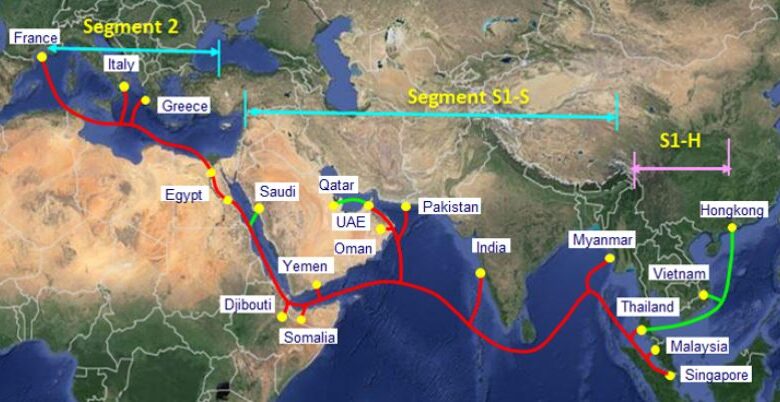
Pakistan Deployment of submarine OFCs and PTCL’s Role
Internet service has been accessible to Pakistani citizens for close to three decades now. At this time, there are around 118.8 million people using the internet in Pakistan, making it the eighth-largest country in the world in terms of internet usage. The information and communications technology sector is one of the most rapidly expanding in Pakistan. In the year 2001, only 1.3% of people in the population had access to the internet. This proportion had increased to 6.5 percent by the year 2006 and had reached 10.0 percent by the year 2012. There were around 118 million residents who had access to the internet as of July 2021. This is equivalent to the percentage of the population that used the internet, which was approximately 54 percent. In addition, there are only a number of companies that operate submarine cable systems. The most well-known of these companies is Pakistan Telecommunication Limited (PTCL), although there is also Transworld. The PTCL now has four major cables that are active, and they are planning to introduce a fifth cable in the not too distant future. Transworld, on the other hand, is only responsible for the operation of two submerged cables.
What exactly is meant by the term “submarine cable system”?
A communication cable that is laid on the bottom of the ocean is the primary component of a submarine cable system. This is where the system gets its name from. In its most basic form, it does this by linking cable landing stations (CLS) located on land in order to send communications signals across vast stretches of ocean. Transmission of international data is typically accomplished through the use of optical fibre cables within submarine cable systems. The quality of transmission that can be delivered by a submarine cable is far higher than that which can be provided by a satellite. Submarine cables are only a few inches thick, and they don’t even have room for very many optical fibres in their construction. Despite this, their capacity for data transmission are measured in terabits per second (Tbps). There is no practicable alternative to these undersea cables, which provide crucial international communications links between states located all over the world.
PTCL was the first company in Pakistan to install submarine cables.
There is no shadow of a doubt that PTCL was the very first submarine cable operator in the country. In addition to satisfying the demands for organic products, capacity is also made available to other operators. There are four cables that are operational:
SMW3
SMW4
IMEWE,
AAE-1 (Asia Africa Europe Cable Systems)
It is anticipated that the implementation of the fifth cable system, Africa-1, would start running by the month of March in 2024.
| Total Cable Length: | 10,000 km |
| No. of Countries: | 8 |
| No. of Landings: | 9 |
| Consortium Parties | 7 |
| Commissioning Year : | 2024 |
| EOL: | 2049 |
In addition, PTCL was a founding member of the majority of the international cable consortiums that serve Asia and the Middle East today. It is important to point out that the SMW3 cable system is the longest one in existence on this planet. In 1999, it started functioning as intended. The subsea cable establishes connections between 33 countries and 39 landing spots, stretching from Western Europe to the Pacific Rim and Australia.
The development of the connection provided by Submarine Cables in Pakistan:
The first submarine coaxial cable, which measured 1177 kilometres in length and was placed in 1986, marked the beginning of the widespread use of submarine cables, as shown in the figure to the right. In 1999, the optical fibre underwater cable known as SMW3 was installed for the very first time in both the east and the west directions simultaneously. After that came SMW4 in 2005, IMEWE in 2010, and AAE-1 in 2017. All of these came after it. In addition, PTCL intends to initiate operations on the Africa 1 underwater cable in the year 2024.
Components That Makeup Underwater Cable Systems:
submarine cable
To begin, there is a cable station that is located at the point from which a land cable is deployed and ultimately enters a beach manhole. As soon as it reaches the ocean, it is transformed into a submarine cable and placed there. As the following picture demonstrates, there are also branching units that are used to separate the undersea cable into two or more distinct sections. After travelling a certain distance, repeaters are installed on the cable to ensure that it is durable and does not become damaged quickly. At last, it arrives at a cable landing point at the location of the destination of its choice.
SMW3 Submarine Cable System:
The world’s longest cable, which connects Western Europe and Southern Europe as shown in the image, then moves towards Eastern Africa and the Middle East, then moves towards South Asia, East Asia, and southeast Asia, and finally reaches Australia. This is the order in which the continents are crossed by the cable.
The total length of the cable is 39,000 kilometres.
36 is the total number of countries.
39 total landings counted
Consortium Parties 92
The year 1999 was the year of commissioning.
EOL 2024
Transmission over a 10G WDM network
Present Capacity 15 Gigabits per second *
The SWM3 cable, which holds the record for being the longest cable on the world, is scheduled to be decommissioned in December of 2024.
Pakistan Deployment of submarine OFCs and PTCL’s Role
SMW4 Submarine Cable:
SMW4 cable
The Silk Road Economic Belt (SMW4) connects Western Europe, including France, to Southern Europe (Italy), then moves towards Eastern Africa and Suez, then the Middle East, then moves towards South Asia, East Asia (only Hong Kong), and finally reaches Southeast Asian countries including Malaysia, Singapore, Vietnam, and so on.
The total length of the cable is 20,000 kilometres.
16 different countries
Landings 14
Consortium Parties 14
2005 is the year that the vessel was put into service.
EOL: 2030
Transmission: 100G DWDM
1.28 Terabits per second was the initial design capacity.
Current Design: 16 terabits per second
Soon, the “upgrade 6” for the SMW4 cable will be introduced, and it will stop working in the year 2030.
AAE-1 Submarine Cable:
After linking Western Europe, Southern Europe, and North Africa, the Southern Main Waterway 4 (SMW4) continues on to Eastern Africa and Suez, the Middle East, and finally South Asia, as well as some portions of South Asia and South-East Asia.
AAE-1 cable
The total length of the cable is 25,000 kilometres.
The total number of countries is 18.
19 are the total landings.
Consortium Parties 19
2016 is the year that the commissioning took place.
EOL: 2041
Transmission: 100G WDM
40 terabits per second was the initial design capacity.
The “upgrade 2” is now being implemented, and it is anticipated that the AAE-1 cable will be decommissioned in the year 2041.
IMEWE Submarine Cable:
IMEWE is a relatively minor cable that connects central and southern Europe, continues into eastern Africa (Suez), and then eventually reaches South Asia. It begins in the middle of Europe and extends southward.
The total length of the cable is 12,000 kilometres.
The number of countries is 8.
The number of landings is ten.
Consortium Parties 9
2010 is the year that the commissioning took place.
EOL: 2035
Transmission: 100G WDM
3.8 terabits per second is the initial design capacity.
The Current Design Amounts to 24 Tbps
The “Upgrade 5” for IMEWE is currently being worked on.
AFRICA-1 Submarine Cable:
Africa (no. 1)
The Africa 1 cable will initially connect countries in Western and southern Europe, including France and Italy. After that, it will move toward the west African state of Algeria, then move towards eastern and southern African states (all the way down to South Africa and Madagascar), then cover the entirety of the Middle East, and then finally reach South Asia.
The total length of the cable is 10,000 kilometres.
The number of countries is 8.
Total Number of Landings: 9
Consortium Parties 7
The year 2024 will mark the beginning of operations.
EOL: 2049
Transmission: 100G DWDM
Capacity at Initial Design Stage Greater than 70 Tbps
The cable is currently being installed, and it is anticipated that operations will commence in 2024.
The Process of Repairing Submarine Cables:
The process of repairing a problem in an undersea cable is laborious, time-consuming, and expensive, often running into the thousands of dollars. In addition, it necessitates the use of cable ships, a number of different permissions, and presents geopolitical challenges. On the other hand, in contrast to land cables, interruptions in service caused by undersea cables are rather uncommon. For example, there were just 19 problems across all 4 cables over the course of three years.
The following are the primary reasons for the error:
Anchors on ships and trawlers used for deep-sea fishing are the most common causes of cable breakage.
Another issue is that there are frequent terrestrial cuts in the Land Segment (Egypt), which is referred to as a huge pain point.
How Can You Prevent a Cable Defect?
Bury the underwater cable in an area with a high potential for danger.
Utilize Early Warning and Avoidance Systems
Determine the optimal paths for the installation of the subsea cables.
Educating people through various programmes shown on cable television.
Keeping to the Cable Protection corridors that have been designated by the government
FAILURE CATEGORIES
The following is a list of some of the several types of cable faults that can occur:
Shunt Fault: OF is intact, however, there is damage to the power insulating
- Cable Cut: Power and OFC have been turned off
- Component failure
- Power re-configuration following a single shunt fault
- Dual Shunt Fault: A Standstill in Traffic
- Traffic slowdown due to cut cable
- How is damage to a marine cable repaired?
The process of repairing the underwater cable is rather involved and time consuming. It entails a number of processes, one of which is receiving approval for a permit from the host state. On January 12th, 2022, for instance, there was a shunt fault that developed into a cable break throughout the course of the day. The distance to the Mumbai Cable station was 110 kilometres. The delay in receiving the permit from India added approximately four months to the period needed for repairs. After that, you will need to enter into a contract with the cable ship, which will cost you many thousand dollars. The cable ship will next locate the fault line and begin its operations, which are described in the video that may be found below.
Obstacles in the Way of Cable Repair:
- The process of entering into an agreement with Repair Ships is a complicated one.
- There are not many ships, and they are shared among the many cables.
- The order in which people submit requests for repairs is taken into consideration.
- Repair Ship & MOD Approvals typically take between three and four weeks to become available.
Conclusion:
There is no doubt that Pakistan Telecom Company Limited (PTCL), the country’s most prominent broadband service provider, is continuously growing and transforming itself in accordance with contemporary expectations. It is a leading participant in the field of offering dependable data connectivity through the diversity of its networks. It is already possible to connect Pakistan to all of the major data centres in Europe, the Far East, and the Middle East thanks to the joint efforts of this company and the leading telecom carriers from across the world. In the end, we are in a position to conclude that PTCL was a significant contributor to the improvement of internet services in Pakistan.



